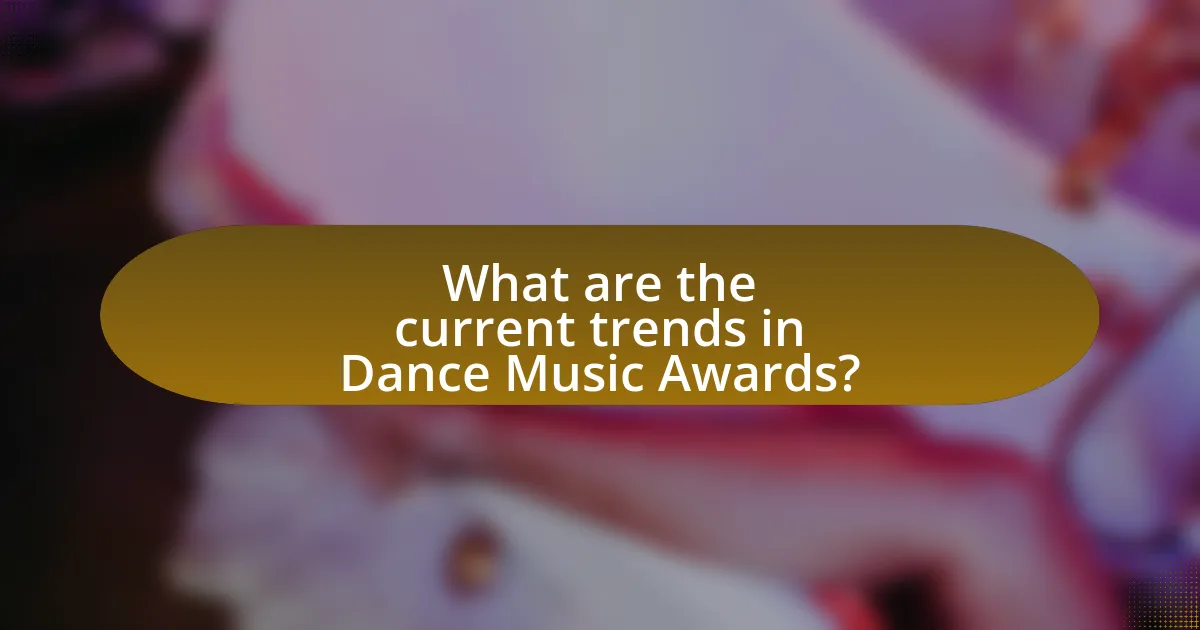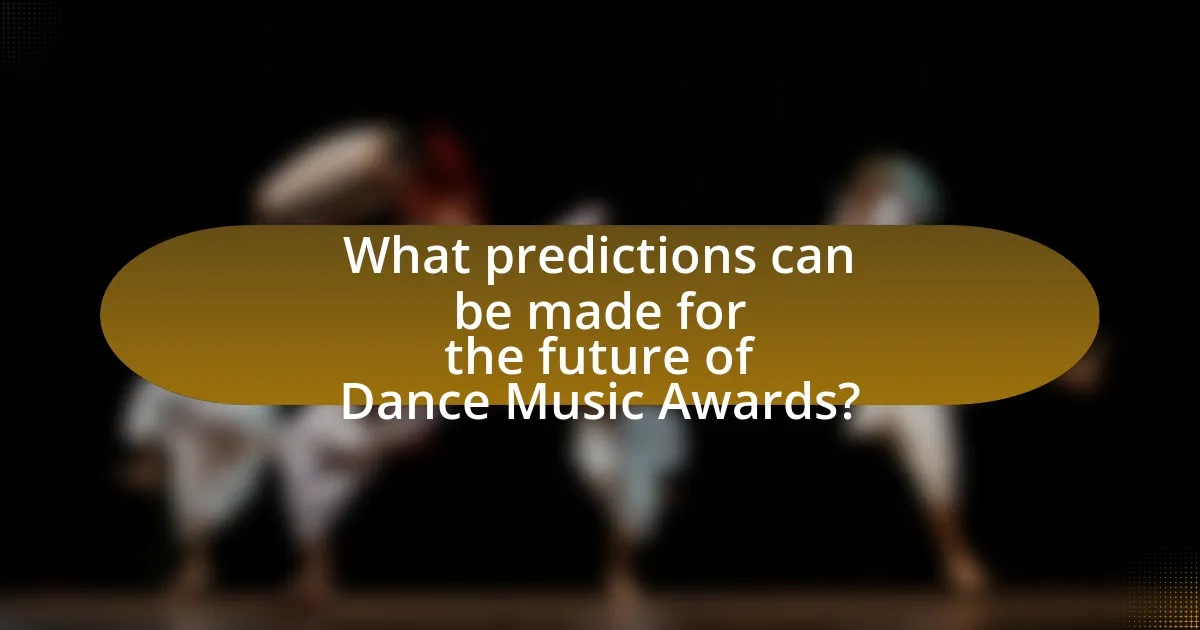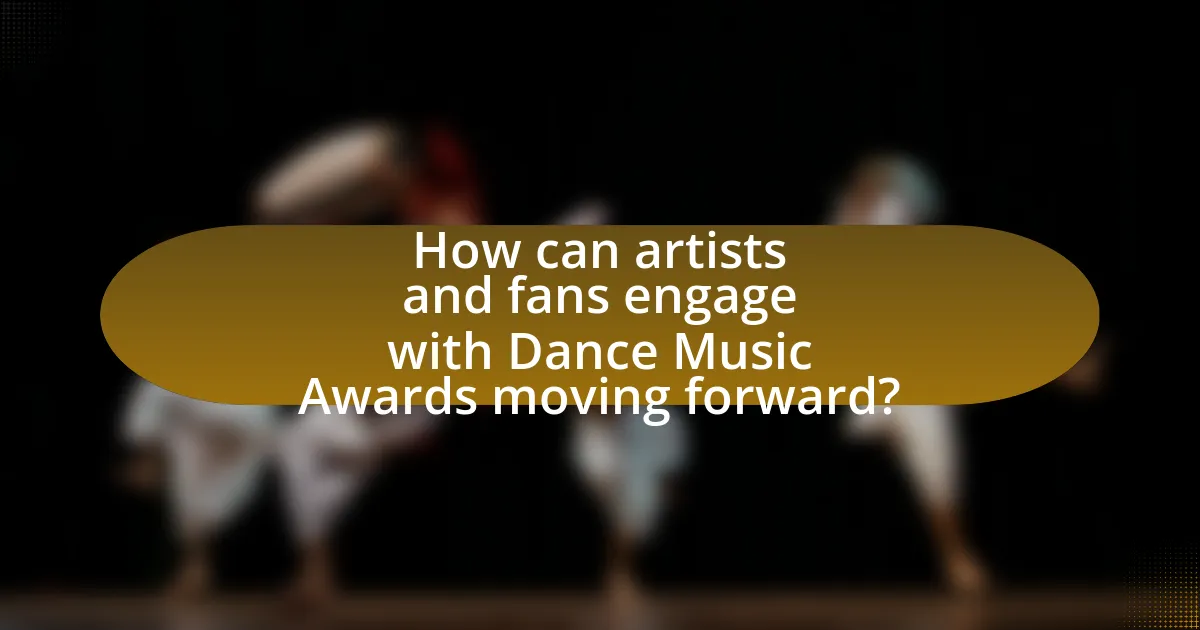The article focuses on the evolving landscape of Dance Music Awards, highlighting current trends such as increased diversity and inclusion, the integration of technology, and the impact of streaming platforms and social media on the awards process. It discusses how recent changes in the music industry have influenced award criteria, the recognition of emerging genres and artists, and the role of fan engagement in shaping outcomes. Additionally, the article explores predictions for the future of the awards, including innovations in voting, the use of virtual and augmented reality, and the importance of demographic shifts and global music markets in enhancing the awards experience.

What are the current trends in Dance Music Awards?
Current trends in Dance Music Awards include a growing emphasis on diversity and inclusion, with awards recognizing a broader range of genres and artists from various backgrounds. Additionally, there is an increasing integration of technology, such as virtual voting and online ceremonies, which became particularly prominent during the COVID-19 pandemic. Data from recent awards shows indicate that fan engagement through social media platforms is also on the rise, allowing for real-time interaction and participation in the voting process. These trends reflect a shift towards a more inclusive and technologically advanced approach in recognizing achievements within the dance music community.
How have recent changes in the music industry influenced Dance Music Awards?
Recent changes in the music industry, particularly the rise of digital streaming and social media, have significantly influenced the Dance Music Awards by shifting the criteria for recognition and visibility. The transition from physical sales to streaming platforms has led to a greater emphasis on online engagement metrics, such as social media followers and streaming numbers, which now play a crucial role in determining award nominees and winners. For instance, the increased accessibility of music through platforms like Spotify and Apple Music has democratized the industry, allowing emerging artists to gain recognition alongside established names, thereby diversifying the award nominations. Additionally, the global reach of social media has enabled fans to participate more actively in the voting process, reflecting a more community-driven approach to the awards. This evolution aligns with broader industry trends that prioritize digital presence and fan interaction, ultimately reshaping the landscape of the Dance Music Awards.
What role do streaming platforms play in shaping these awards?
Streaming platforms significantly influence the shaping of dance music awards by providing a primary distribution channel for artists and their music. These platforms, such as Spotify and Apple Music, have transformed how audiences consume music, leading to increased visibility for artists and their work. The data generated from streaming metrics, including play counts and listener demographics, directly impacts award nominations and winners, as many awards now consider streaming performance as a key criterion. For instance, the Grammy Awards have acknowledged the importance of streaming data in their voting processes, reflecting the industry’s shift towards digital consumption. This integration of streaming analytics into award considerations underscores the platforms’ pivotal role in determining which artists gain recognition and accolades in the dance music genre.
How has social media impacted the visibility of Dance Music Awards?
Social media has significantly enhanced the visibility of Dance Music Awards by providing a platform for real-time engagement and promotion. The integration of social media channels allows for widespread sharing of content related to the awards, including nominations, voting processes, and event highlights, which increases audience reach. For instance, platforms like Instagram and Twitter enable fans to interact directly with artists and the awards, fostering a community that amplifies visibility through user-generated content and viral marketing. Additionally, statistics show that events promoted on social media can achieve up to 70% higher engagement rates compared to traditional marketing methods, demonstrating the effectiveness of social media in elevating the profile of Dance Music Awards.
What emerging genres are gaining recognition in Dance Music Awards?
Emerging genres gaining recognition in Dance Music Awards include melodic techno, bass house, and future rave. Melodic techno has seen a rise in popularity due to its emotive soundscapes and has been featured prominently in recent award nominations. Bass house, characterized by its heavy basslines and energetic beats, has also gained traction, appealing to a younger audience. Future rave, a genre blending elements of trance and techno, has been recognized for its innovative sound and has been highlighted in various industry discussions. These genres reflect the evolving landscape of dance music and are increasingly acknowledged in award ceremonies.
Which new artists are making waves in the dance music scene?
New artists making waves in the dance music scene include Dom Dolla, who gained recognition for his hit “Take It,” and LP Giobbi, known for her energetic performances and innovative sound. Both artists have been featured prominently in major festivals and have garnered significant streaming numbers, indicating their rising influence. Dom Dolla’s tracks have charted on Beatport, while LP Giobbi has been highlighted in industry publications for her contributions to the genre.
How are traditional genres evolving within the awards framework?
Traditional genres are evolving within the awards framework by increasingly incorporating elements from diverse musical styles and recognizing innovative sub-genres. This evolution is evident in major awards shows, which have expanded their categories to include hybrid genres, reflecting the blending of traditional forms with contemporary influences. For instance, the Grammy Awards introduced categories like Best Dance/Electronic Album, acknowledging the growing impact of electronic music on traditional genres. This shift demonstrates a broader acceptance of genre fluidity, allowing artists to be recognized for their unique contributions that transcend conventional boundaries.

What predictions can be made for the future of Dance Music Awards?
The future of Dance Music Awards is likely to see increased integration of technology and social media in the voting and nomination processes. As the popularity of electronic dance music continues to rise, platforms such as TikTok and Instagram will play a crucial role in shaping public engagement and participation in the awards. Additionally, the awards may expand to include more diverse genres and sub-genres within dance music, reflecting the evolving landscape of the music industry. This trend is supported by the growing number of electronic music festivals and events, which have seen attendance increase by over 50% in the last decade, indicating a robust and expanding audience for dance music.
How might technology change the way Dance Music Awards are presented?
Technology will significantly change the presentation of Dance Music Awards by enabling immersive experiences through virtual reality (VR) and augmented reality (AR). These technologies allow audiences to engage with performances and award ceremonies in a more interactive manner, enhancing viewer participation and enjoyment. For instance, VR can create a virtual venue where fans from around the world can attend the awards in real-time, while AR can overlay digital elements onto live performances, making them more visually captivating. Additionally, advancements in live streaming technology will facilitate higher-quality broadcasts, reaching a broader audience and allowing for real-time voting and engagement through social media platforms. This shift towards a more technologically integrated presentation aligns with trends in the entertainment industry, where digital experiences are increasingly prioritized to attract and retain audiences.
What innovations in voting and participation could emerge?
Innovations in voting and participation could include blockchain technology for secure and transparent voting processes. Blockchain can enhance trust by providing an immutable record of votes, reducing the risk of fraud. Additionally, mobile voting applications could emerge, allowing users to cast their votes conveniently from their smartphones, thereby increasing participation rates. Research indicates that mobile voting can lead to higher engagement, particularly among younger demographics, as seen in various pilot programs across the United States. Furthermore, the integration of social media platforms for real-time voting and feedback could foster a more interactive and engaging experience for participants, aligning with trends in digital communication and community building.
How could virtual reality and augmented reality enhance the awards experience?
Virtual reality (VR) and augmented reality (AR) could significantly enhance the awards experience by creating immersive environments that engage attendees in unique ways. VR can transport users to virtual venues where they can experience performances and award presentations from various perspectives, making them feel as if they are part of the event regardless of their physical location. AR can overlay digital elements onto the real-world environment, allowing attendees to interact with 3D models of trophies or view real-time statistics about nominees and winners through their devices.
For instance, a study by PwC found that immersive technologies like VR and AR can increase audience engagement by up to 70%, demonstrating their potential to transform traditional award ceremonies into interactive experiences. This integration not only enhances the entertainment value but also broadens accessibility, allowing fans worldwide to participate in the celebration of their favorite artists and genres.
What shifts in audience demographics are expected for Dance Music Awards?
Shifts in audience demographics for Dance Music Awards are expected to include an increase in younger attendees, particularly those aged 18 to 24, as well as a more diverse representation in terms of ethnicity and gender. This trend is supported by data indicating that electronic dance music (EDM) has gained significant popularity among younger generations, with a 2022 survey showing that 70% of festival-goers were under 30 years old. Additionally, initiatives aimed at promoting inclusivity within the dance music scene have led to a rise in female and non-binary participants, reflecting broader societal movements towards diversity.
How will the rise of global music markets affect the awards?
The rise of global music markets will diversify the criteria and categories for music awards. As artists from various cultural backgrounds gain international recognition, awards will likely expand to include genres and styles that reflect this global influence. For instance, the inclusion of Afrobeat and K-pop in mainstream music has already prompted awards to adapt, as seen with the Grammy Awards introducing a Best Global Music Album category in 2021. This trend indicates that awards will increasingly recognize a broader range of musical expressions, aligning with the global audience’s preferences and consumption patterns.
What role will diversity and inclusion play in future awards?
Diversity and inclusion will play a critical role in future awards by ensuring representation across various demographics, including gender, ethnicity, and sexual orientation. This shift is driven by a growing recognition of the importance of diverse perspectives in the creative process, which enhances innovation and audience engagement. Research indicates that organizations with diverse teams are 35% more likely to outperform their competitors, highlighting the tangible benefits of inclusivity. As a result, future awards are likely to implement criteria that prioritize diversity, reflecting broader societal values and fostering a more equitable industry.

How can artists and fans engage with Dance Music Awards moving forward?
Artists and fans can engage with Dance Music Awards moving forward by utilizing digital platforms for voting, participation in live events, and social media interactions. Digital platforms allow fans to vote for their favorite artists, enhancing their involvement in the awards process. Live events provide opportunities for artists to perform and connect with fans, fostering a sense of community. Social media interactions enable real-time engagement, where fans can share their experiences and support their favorite artists, creating a dynamic dialogue around the awards. This multi-faceted approach not only strengthens the relationship between artists and fans but also increases the visibility and relevance of the Dance Music Awards in the evolving music landscape.
What strategies can artists use to increase their chances of winning awards?
Artists can increase their chances of winning awards by focusing on high-quality production, engaging with their audience, and strategically submitting their work to relevant competitions. High-quality production enhances the overall appeal of their music, making it more likely to be recognized by judges. Engaging with their audience through social media and live performances builds a loyal fan base, which can influence award outcomes through voting or support. Additionally, researching and targeting competitions that align with their genre and style ensures that their submissions reach the right audience, increasing the likelihood of recognition.
How important is fan engagement in the awards process?
Fan engagement is crucial in the awards process as it directly influences the visibility and credibility of the awards. Engaged fans contribute to voting, promote nominees, and create a sense of community around the event, which can significantly enhance its reach and impact. For instance, the Grammy Awards have seen increased participation and viewership due to active fan involvement in social media campaigns and voting processes, demonstrating that fan engagement can lead to higher ratings and greater industry recognition.
What platforms should artists utilize to promote their work for awards consideration?
Artists should utilize platforms such as social media, music streaming services, and industry-specific websites to promote their work for awards consideration. Social media platforms like Instagram, Twitter, and Facebook allow artists to engage with fans and industry professionals, increasing visibility. Music streaming services like Spotify and SoundCloud provide opportunities for artists to showcase their work to a broader audience and gain traction through playlists. Additionally, industry-specific websites and forums, such as Resident Advisor and Beatport, offer dedicated spaces for artists to share their music and connect with award committees. These platforms collectively enhance an artist’s chances of being recognized for awards by maximizing exposure and engagement within the music community.
What best practices should fans follow to support their favorite artists in the awards?
Fans should actively vote for their favorite artists during awards to ensure their support is reflected in the outcomes. Engaging in voting processes, whether through online platforms or in-person events, directly influences the recognition artists receive. Additionally, fans can promote their favorite artists on social media by sharing posts, using relevant hashtags, and encouraging others to participate in voting. This collective action amplifies visibility and can sway public opinion. Historical data shows that fan engagement significantly impacts award results, as seen in the Billboard Music Awards, where fan votes account for a substantial portion of the final tally.
How can fans effectively participate in voting and promotion?
Fans can effectively participate in voting and promotion by actively engaging on social media platforms and utilizing official voting channels provided by the awards. Engaging on platforms like Twitter, Instagram, and Facebook allows fans to share their support for their favorite artists, while official voting websites or apps ensure their votes are counted accurately. According to a survey by Pollstar, 70% of fans reported that social media campaigns influenced their voting decisions, highlighting the importance of online engagement in the promotion of artists during award seasons.
What resources are available for fans to stay informed about Dance Music Awards?
Fans can stay informed about Dance Music Awards through official websites, social media platforms, and dedicated music news outlets. The official website provides updates on nominees, voting processes, and event details, while social media channels like Twitter, Instagram, and Facebook offer real-time announcements and fan interactions. Additionally, music news outlets such as Billboard and DJ Mag frequently cover the awards, providing insights and analysis. These resources ensure fans have access to the latest information and developments regarding the Dance Music Awards.
